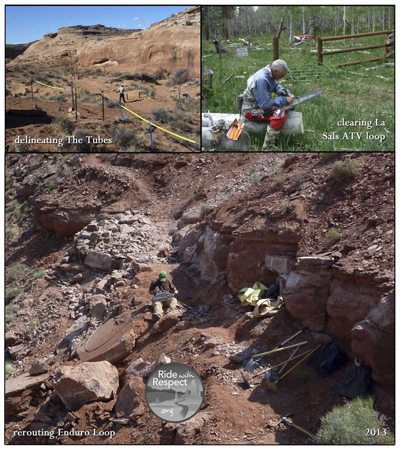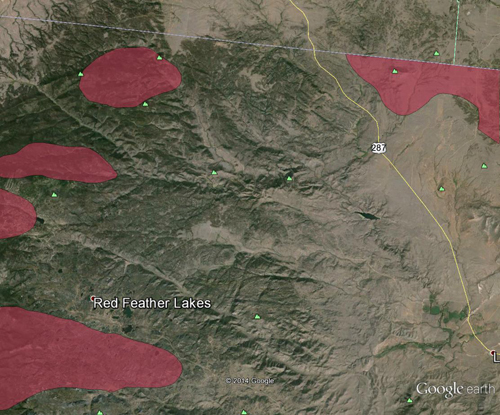Reprinted with permission
Ride with Respect Year in Review 2013
www.ridewithrespect.org
Winter set in early around Moab. It’s a good thing that RwR was so active during the first half of 2013. Our nonprofit was busy conserving shared-use trails and their surroundings.
In fact, RwR’s work has nearly outpaced its budget. If you haven’t already contributed time or money this year, please consider sending a check to Ride with Respect, 1310 Murphy Lane, Moab UT 84532. (As a 501c3 organization, all donations are tax-deductible.)
Many employers will effectively double your donation through their matching-gift programs. Particularly in larger companies, human-resources departments will typically instruct you to make the donation and then submit a form requesting the match. Next the company will contact RwR to verify receipt of your donation, and finally they’ll match it dollar for dollar!
RwR’s productivity is due to many individual contributors as well as Grand County, Utah State Parks, Colorado Trails Preservation Alliance, and the Yamaha OHV Access Initiative.These four organizations have supported us for many years, so we cannot thank them enough.
To highlight our recent accomplishments, let’s go from northwest to southeast.
DEAD COW – In case you’re wondering, Dead Cow is the name of an off-highway vehicle (OHV) trail near the town of Green River. It’s a tough one to manage, being important recreationally and ecologically. Over the years, Dead Cow and another odd-sounding trail, The Tubes, have become quite braided. Fortunately the Bureau Of Land Management (BLM) supplied RwR with a few thousand pounds worth of sign and fence supplies. We spent a few hundred hours marking the trail and blocking the braids (see attached photo). So far this mitigation is working to restore some vegetation and preserve access along the main route.
ENDURO LOOP – Also up toward Green River, a motorized single track traverses three steep hills. They provided great challenge, but were eroding into nearly-impassable ledges. Rerouting to a more gradual line will be less challenging but longer and, most importantly, durable. RwR spent five-hundred hours constructing the new lines(see attached photo), and the BLM matched those hours!RwR volunteer groups included Northern Colorado Trail Riders and Bookcliff Rattlers Motorcycle Club.BLM volunteer groups included a local Boy Scout troop and University of Virginia service project, plus the Utah Conservation Corps. By springtime, we’ll close the old lines and open up the new ones.
SOVEREIGN TRAIL – You may recall that last year RwR marked a 4WD trail at the north end of Sovereign Trail System. Originally to be named after Brody Young, the State Parks ranger decided on Fallen Peace Officer Trail. That name set the stage for a memorial event this past spring. The Utah Peace Officers Association(UPOA)got help from RwR, local government, the Utah State Parks OHV Advisory Council, and the Utah division of Forestry, Fire, & State Land: Read Moab Sun News Article»
That day, rain made the trail muddy, and most participants were smart enough to postpone the ride. At the ceremony, a few hundred folks came with rain coats and left with a profound appreciation for our public servants in law enforcement: Watch YouTube Video here»
Let’s hope that next year’s event, on April 5th, will be equally moving and a bit more sunny.
LA SAL MOUNTAINS – Over the last several years, RwR has developed a trail system in the eastern La Sals with the Utah School & Institutional Trust Lands Administration. This year, our partnership was the subject of a couple television segments:
AYL segment – SITLA swap Trailhead – watch here»
AYL segment – La Salle Mountains Travel – watch here»
In Utah, At Your Leisure airs every Sunday morning at 9:00, right after a show on local government, The County Seat. In other states, check your television listing, or watch episodes online:
http://ayltv.com/index.html
http://thecountyseat.tv/
RwR didn’t finish installing more OHV cattle guards, but we look forward to working with SITLA as well ast he U.S. Forest Service in the La Sals next summer.
EDUCATION – A broad base of tourism has sustained Moab’s economy for the last couple of decades. The crowds can create certain problems of success, such as use conflicts and loving the land to death. Visitors don’t automatically know to stay on the trail and yield for others. Fortunately there are outlets willing to spread the word. Statewide, the RIDE ON Utah campaign is being developed by Tread Lightly: Read more here»
This past year RwR worked with the Moab Area Travel Council to introduce opportunities for motorcycle trail riding: discovermoab.com/motorcycle_moab.htm
We also worked with the Moab Times-Independent to produce OHV-trail reviews in seven editions of Explore Moab (all months except August): Read them all here»
For an electronic version of the main publication, you can subscribe here» Of course a paper version is also available here»
Both the Moab T-I and the Moab Area Travel Council generously provided forums to promote a trail ethic.
BICYCLING – Most editions of Explore Moab also feature an article from Trail Mix, which is Grand County’s committee on non-motorized trails (watch video here») Developing new trails for bicycling, hiking, and equestrian use takes some pressure off of the motorized trails. In the past few years, Trail Mix has constructed about seventy-five miles of mountain-bike trails, plus paved paths. They aim to double thatmileage, and maintain the routes. This halfway point provides a moment to thank Trail Mix. The group includes outstanding volunteers like Sandy and Geoff Freethey, partners like Moab Trails Alliance, and others like the new local chapter of IMBA: http://moabmba.com/ Their combined efforts are diversifying the area’s recreation opportunities and improving the general quality of life.
RECOGNITION – Christmas came early for Clif at the annual conference of the National Off-Highway Vehicle Conservation Council (NOHVCC). The group awarded me with State Partner of the Year (read article here»)
It’s gratifying to be a small part of NOHVCC’s big accomplishments. The group bridges gaps between OHV advocates and land managers. For examples, you can check out many presentations from the conference here»
Currently the partner position is open in a handful of states: nohvcc.org/Contacts/PartnerContact
If you know of OHV leaders in those states, encourage them to apply.
MORE RECOGNITION -Likewise Dale got some press this year: Moab Times story The article highlights many of his accomplishments to date. Regarding RwR, it mentions his transition from executive director to chairman of the board. Although he won’t be doing the daily tasks of operation, Dale is committed to helping guide and grow the organization. Already we’ve come a long way, and had nearly a thousand people contribute to responsible recreation through RwR (see attached letter). It all started when Dale got an attorney to write the articles of incorporation, and got friends to restore areas like Tusher Tunnel. With hindsight, these seem like simple steps. But at the time, the horizon was dusty. Dale squinted his eyes, gripped the tank, and twisted the throttle. For that leap of faith, I am grateful.
Happy Holidays!
Clif Koontz,
executive director

I feel compelled to go back a few years before RWR as it is our ten year anniversary. Way back when I was one of those California guys, I always felt that all of us who use public land should be involved in the the processes that make our use possible. I can remember back in 1963 when the US Forest Service made it mandatory to have a spark arrestor. I went to a meeting of one of the local MC clubs. A forest ranger was a special speaker. It was this guys mission to make sure that everyone riding a Moto in US forests had a sparkarestor mounted on his or her Moto. I sat there in my seat and tried to think of a single instance where carbon from a pipe or even exhaust flames from a pipe ever have been actually been the cause of a forest fire or a brush fire. Most of us ran Two strokes that ran so rich that the oil would spit out of the pipe not carbon or flame. The only time I ever saw a moto start a fire is when it go laid over in dry grass and the outside of the pipe mixed with gas or just the heat of the pipe started a little fire. To make things worse, the Forest ranger told me that I had to have a forest service approved arrestor, with a special stamp on it. Now that was enough to get me really riled up! Here was some guy telling me that I had to go (PURCHASE) something that I could make for darned near nothing, with no option to go into a forest service office and get mine checked out. This was my first real first hand experience with my own Government making a ruling that made no sense in a scientific manner or even a practical manner. The law was passed purely to pacify folks that did not have actual field experience in the cause of fires, but felt that the stuff coming out of the pipe had to be the culprit.
For years I felt guilty for not taking part in land use and trail development, always with the thought of how I could get something going that made sense to the natural environment and to the general public. As humans we tend to make most our decisions on something we have heard ,or just a knee-jerk reaction to a situation that comes up. In forming Ride With Respect, I decided to surround myself with folks that have an education in the different facets of land use. Our board is made up of folks that know way more about the science than I will ever know, but because of them we have made a very successful team. Do some of us go over the edge once in a while YES!!!, but the process as a whole is working very good.
With very little money Ride With Respect has been successful A major influence in the latest resource plans of the State of Utah, US forest service, and the BLM in our area. Fact is, we have been a conduit for many of the land use organizations and clubs for all the time we have been assembled as a group. Without the help of these groups, Ride With Respect would have not been able to get anything at all done on the ground. I believe that we have changed the perception of motorcyclists in general for the better, especially around Moab, to a point where we (riders) are looked upon as friends, not someone that is just out to scare folks and make noise.
In ten years Ride With Respect has helped educate folks on land use, not only by talking at meetings, but, much better by the way we act and execute our actions. The government land managers are now giving RWR many opportunities to build more and better sustainable trails.
TEN years; RWR/ Bookcliff Rattlers Thompson Trail
Moab BLM RMP
Sovereign trail system
Behind the rocks
State forest single track
New re-route Robertson Pasture Abjo Mountains
Re-route Red Ledges
Re-route endro loop
Many field days with Grand County residents, and other friends
As I step down in order to get some Hot Rods / old bikes built,— and do some more exploring Thanks to all of you great folks that have been with us. The ball is now on a roll, o’l Dale will still be out there clearing trail, but no more phone calls and meetings! Thanks to everyone once more, It has been a great ride, come try to catch me some day!
Dale L. Parriott

